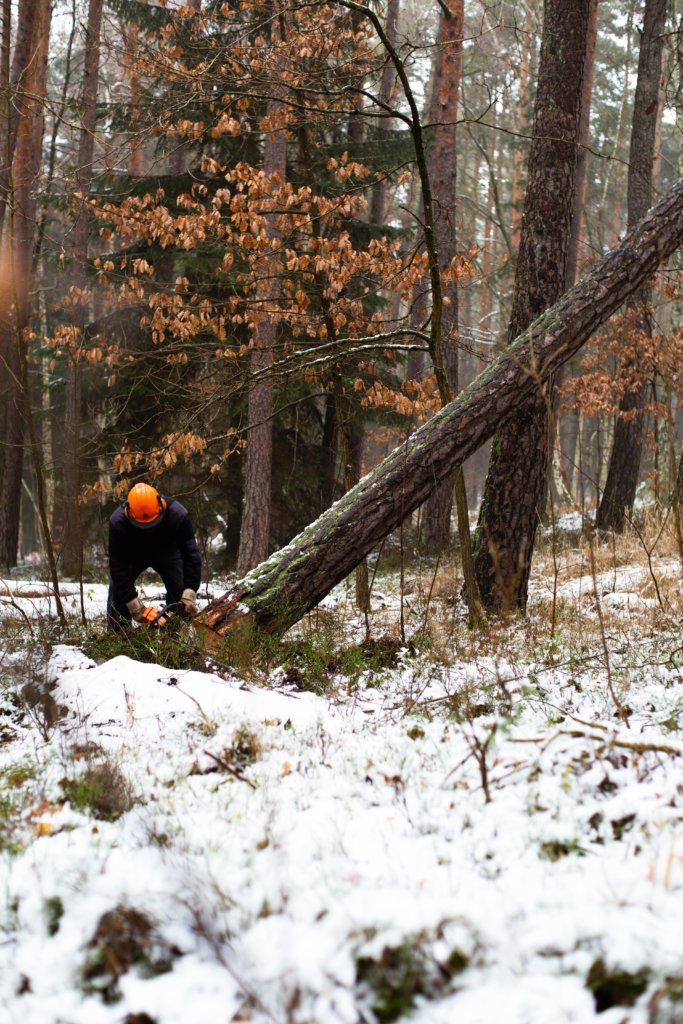What is a tree surgeon?
A tree surgeon is someone who specialises in the maintenance of trees. They can be tasked with pruning, felling, planting and general maintenance.
As a tree surgeon, you’ll play an important role in each stage of a tree’s life cycle. By looking after trees, you’re helping to preserve this important part of our ecosystem.

What does a tree surgeon do?
No two days are the same for a tree surgeon, whether you’re working in gardens, parks or woodlands, you’ll undertake a variety of different duties. These include:
- Tree inspections
- Branch removal
- Crown reduction
- Crown lifting
- Tree surveys
- Tree felling
- Tree stump and root removal
- Hedge trimming and reduction
- Tree pollarding
- Deadwooding
- Tree planting
What skills are needed to become a tree surgeon?
Working as a tree surgeon is a physically demanding job. For this reason, it’s important to have the right skills for the role.
Some key skills that you’ll need include:
- A passion for the outdoors
- An interest in ecology and nature
- A willingness to work in all weathers
- Extensive knowledge of trees and vegetation
- Excellent problem solving skills
- A strong sense of responsibility
- An ability to remain calm in stressful situations
- Strong communication skills
- Excellent physical skills such as movement and coordination
- An ability to work at heights
- Attention to detail
- The ability to safely use machines and tools
What qualifications are needed to become a tree surgeon?
There aren’t any required qualifications to become a tree surgeon but completing a course or gaining work experience is a great way to build up your knowledge and expertise. College courses, university degrees, diplomas, apprenticeships or volunteering can all help aspiring tree surgeons to develop those all important skills.
Universities offer courses such as forestry, arboriculture, forest management, woodland ecology and conservation, all of which are relevant to this line of work. Alternatively, colleges offer qualifications such as a level 2 certificate in arboriculture or a level 2 certificate in felling and processing trees.
In some cases, you may be required to have a certificate of competence(1) before carrying out hazardous tasks, such as using chainsaws or climbing trees.
“You get to meet so many new people and every job is different so you’re always learning and never know what your next challenge will be.”
Matt(2)
Steps to become a tree surgeon
If you’d like a career as a tree surgeon, here are the steps you’ll need to take.
Step 1: Gain relevant qualifications
If you’d like to build up your skill set before beginning your career as a tree surgeon, it’s worth looking into relevant college, university or apprenticeship courses. The more qualifications you have, the easier it’ll be to find a job in the future.
You’ll usually need at least some GCSEs or equivalent to undertake a college course or to get an apprenticeship, but this will vary for each provider. To enrol for a degree, you’ll often need two to three A levels or equivalent, but again it’s important to check the specific university’s requirements.
City and Guilds NPTC(3) certificates of competence can be achieved through undertaking short courses that are highly relevant to tree surgeons. These include courses such as a level 2 certificate of competence in chainsaw maintenance and cross-cutting and a level 2 certificate of competence in tree climbing and aerial rescue.
Step 2: Find work experience
Gaining practical experience is the best way to put any skills you’ve learnt into practice. You could volunteer to be a grounds person, helping qualified tree surgeons from the ground.
It’s also worth volunteering in other related fields, such as gardening or conservation roles which will still help you attain valuable knowledge. You could approach organisations and charities to see if they have any volunteering opportunities.
Step 3: Secure a job as a tree surgeon
Once you have the skills required, it’s time to start looking for a paid role. You can find job vacancies advertised online or in local magazines and newspapers. You’ll often find companies looking for trainee tree surgeons with little or no experience required.

How much does a tree surgeon earn in the UK?
The average starting salary for a tree surgeon is around £20,000 per year, rising to around £38,000(4) with experience. However, these figures vary heavily depending on location and the company you choose to work for. Alternatively, you could start your own tree surgery business, giving you flexibility over the rates you charge.
What’s the difference between a tree surgeon and an arborist?
The terms tree surgeon and arborist tend to be used interchangeably, but there is a slight difference between the two. Arborists focus on tree management, helping to keep your trees in the best condition. They can inspect trees for signs of disease and give you expert advice on how to care for them.
On the other hand, tree surgeons also have extensive knowledge of trees but their role is more focused on carrying out the mechanical work, such as branch removal, crown reduction and tree felling.

